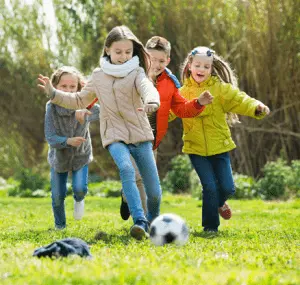
Define recess
When creating laws and policies it is essential that within this process recess be defined. Further, the definition must include language to ensure students are allowed to engage in physical activity of their choosing. Without this language loopholes will be found. For instance, I have heard, “Yes they have to sit out but it’s still ‘recess’ from learning” or “I’m not taking activity time at recess away, they are walking laps because they forgot homework.” Anyone’s blood boiling yet? One definition that helps specify what recess is and avoid loopholes is provided by the Active Living Research Brief. It defines recess this way: “Recess is scheduled outside of class time and allows students to engage in physical and social activities of their choice.” This can be better worded to meet your needs. However, the key is to ensure students have the chance to engage in physical activity that they choose, obviously with parameters, and minimize the chance for less than desirable loopholes.
Change the recess environment
Take a look at the recess environment at your school. Would you want to go there to be active? If there were 400 of my peers with one supervisor and I wasn’t confident or was afraid of being picked on, I wouldn’t venture out into that abyss. If there were two basketballs, a jump rope, and a bunch of dead grass, that’s not the active environment I would choose. We have to consider this. The research is pretty clear that zoning the recess environment off, providing inexpensive recreational equipment (not playground sets), training staff, and painting the space to be more appealing, all increase activity levels. The research and summary of these can be found in the ALR brief mentioned above. Also, Gopher has an excellent program called Active and Healthy Schools that can assist you in making your recess environment more appealing.
Teach recess activities in physical education
Almost 15 years ago I stumbled onto this phenomenon. I was doing research on recess and I noticed that the students were playing Four Ball Soccer (or how many ever soccer balls they had that day). This seemed very odd because most students would not think of this. If there aren’t uniforms, lines, and adults there to ruin it, they don’t know how to play soccer. I asked the physical education teacher about it and he said, “Oh we teach a bunch of recess activities at the beginning of the year so they know some options.” GENIUS. Of course, he had been doing this for 20 years and I was late to the dance. This strategy does not take away from physical education time; in fact it lends itself to what we are supposed to be doing, promoting physical activity. This strategy also allows students to see the link between physical education lessons and physical activity beyond the gymnasium. Some examples of activities that can be taught in physical education and then used at recess are:
- Four Ball Soccer – Played like normal soccer except there are four balls used rather than one. Also, the player who kicks the ball out of bounds has to chase it. This tends to cut down on players kicking as hard as they can.
- Dance Party – Teach some dances during a physical education lesson. At recess, turn on the songs and let them dance. They can do the dances taught or make up their own… as long as they are appropriate.
- Walking interview – Designate a walking trail on the playground and provide students with cards with questions. This will help get the conversation started.
Equipment checkout
When I was teaching, equipment loss at recess was always a challenge and costly. I believe there are still missing playground balls on the Dallas Tollway, which was just a fence and tiny road away from the playground. On a trip to England several years ago I was shown yet another GENIUS idea. The school had a small shed that housed the recess equipment. At the beginning of the year each student was given a small token. A piece of wood they can decorate and put their name on works perfectly. Each week a different class served in the shed as the equipment managers during recess. Typically, only one or two students were needed per day. Students then gave the managers their token in exchange for a piece of equipment. When the equipment was returned, so was the token. If equipment was not accounted for, the last user was known. This process virtually eliminated equipment loss and put ownership/responsibility on the students.
These are just a few ideas. I ran out of space and didn’t get to address more ideas like indoor recess, intramurals, and teacher engagement. All great ideas that I have stolen over time. Give the ideas here a shot and see if it helps maximize recess time. Thrive!




